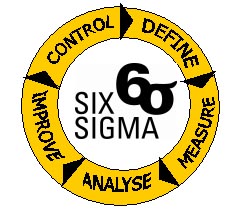 Are Six Sigma and Innovation inherent enemies or powerful allies?
Are Six Sigma and Innovation inherent enemies or powerful allies?
Some would say that Six Sigma and innovation are diametrically opposed goals for an organization to pursue. Some say that organizations cannot excel at both and would point to the issues that 3M has run into with its ability to innovate after a CEO James McNerny came in and introduced Six Sigma into the organization.
I disagree that it is not possible to pursue a dedication to continuous improvement and reduction in variability while also challenging the organization to identify ways to deliver greater value to customers through innovation.
I am happy to take the opposite position and say that Six Sigma can in fact accelerate an organization’s ability to innovate. How can this be?
Well, given the cost cutting efforts throughout organizations across all industries of the past couple of decades, most employees are incredibly overworked and struggling to keep their heads above water. American employees work more hours per year and take fewer days off than any employees in the world. The result is that employees often do not have the time to devote to activities related to innovation because they are buried in the execution of administrative and other urgent tasks. Why is this important?
Creative thinking requires the mind to explore different perspectives and possibilities in order to come up with innovative approaches to solutions. This requires time, usually blocks of uninterrupted time. If workers don’t have the time to devote to innovation pursuit, then organizations will struggle to deliver anything other than incremental improvements.
The power that Six Sigma holds to accelerate innovation is through its inherent focus on continuous improvement. By a disciplined approach to Six Sigma methodologies, efforts can be focused on identifying the heat sinks in employee workloads (those activities that require a large time investment but deliver low return). Projects can then be prioritized for maximum employee workload reduction. Utilizing Six Sigma methodologies, organizations have the potential of reducing employee frustration while simultaneously increasing the employee energy available to focus on innovation.
Despite most people’s contentions that Six Sigma and innovation are natural enemies, I believe they can be the best of friends, but it would take a disciplined, integrated approach on behalf of the organization. Does your organization have the discipline, vision and commitment?
If you enjoyed this 2007 classic, you’ll enjoy my more recent article on Six Sigma and innovation titled – DMAIC for Innovation

 Sign up here to get Human-Centered Change & Innovation Weekly delivered to your inbox every week.
Sign up here to get Human-Centered Change & Innovation Weekly delivered to your inbox every week.
![]() Sign up here to get Human-Centered Change & Innovation Weekly delivered to your inbox every week.
Sign up here to get Human-Centered Change & Innovation Weekly delivered to your inbox every week.

 In this economic downturn there is more pressure than ever on executives to find new sources of growth, and as a result leaders are increasingly talking about innovation. In some organizations the leader may say “we need to be more innovative” or “we need to think out of the box” and stop there. While for other organizations it may become part of the year’s goals or even the organization’s mission statement. Only in a small number of cases will there be any kind of sustained effort to enhance, or create, a culture of continuous innovation.
In this economic downturn there is more pressure than ever on executives to find new sources of growth, and as a result leaders are increasingly talking about innovation. In some organizations the leader may say “we need to be more innovative” or “we need to think out of the box” and stop there. While for other organizations it may become part of the year’s goals or even the organization’s mission statement. Only in a small number of cases will there be any kind of sustained effort to enhance, or create, a culture of continuous innovation.
 Are Six Sigma and Innovation inherent enemies or powerful allies?
Are Six Sigma and Innovation inherent enemies or powerful allies? There is more talk about strategic innovation every day. As more and more industries enter their commodity phase, companies are looking to differentiate themselves and increasingly they are turning to strategic innovation to do so. The art of strategic innovation has been the subject of many books including: Dealing with Darwin, Blue Ocean Strategy, and Fast Second. Books on the topic detail the virtues of creating a strategy that separates you from your competitors’ strategies.
There is more talk about strategic innovation every day. As more and more industries enter their commodity phase, companies are looking to differentiate themselves and increasingly they are turning to strategic innovation to do so. The art of strategic innovation has been the subject of many books including: Dealing with Darwin, Blue Ocean Strategy, and Fast Second. Books on the topic detail the virtues of creating a strategy that separates you from your competitors’ strategies.